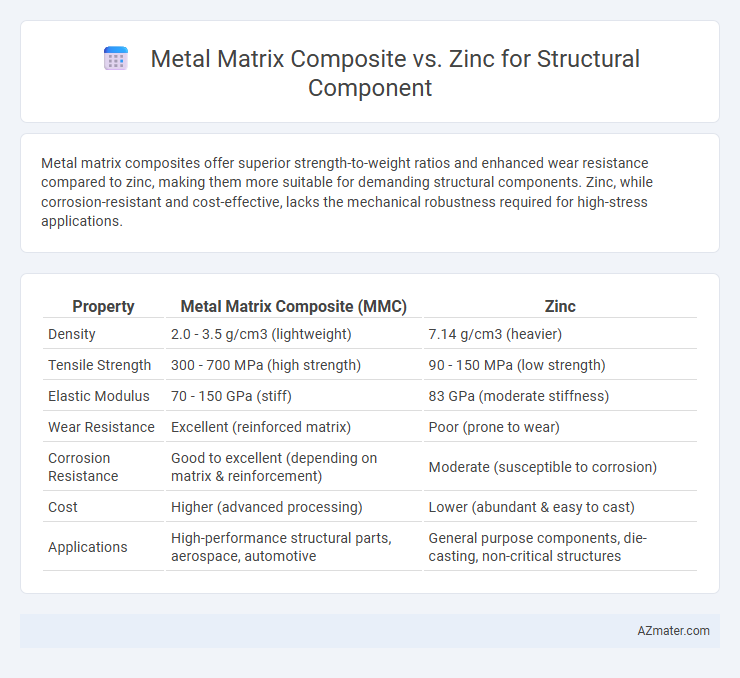Metal matrix composites offer superior strength-to-weight ratios and enhanced wear resistance compared to zinc, making them more suitable for demanding structural components. Zinc, while corrosion-resistant and cost-effective, lacks the mechanical robustness required for high-stress applications.
Table of Comparison
| Property | Metal Matrix Composite (MMC) | Zinc |
|---|---|---|
| Density | 2.0 - 3.5 g/cm3 (lightweight) | 7.14 g/cm3 (heavier) |
| Tensile Strength | 300 - 700 MPa (high strength) | 90 - 150 MPa (low strength) |
| Elastic Modulus | 70 - 150 GPa (stiff) | 83 GPa (moderate stiffness) |
| Wear Resistance | Excellent (reinforced matrix) | Poor (prone to wear) |
| Corrosion Resistance | Good to excellent (depending on matrix & reinforcement) | Moderate (susceptible to corrosion) |
| Cost | Higher (advanced processing) | Lower (abundant & easy to cast) |
| Applications | High-performance structural parts, aerospace, automotive | General purpose components, die-casting, non-critical structures |
Introduction to Structural Materials
Metal matrix composites (MMCs) offer superior strength-to-weight ratios and enhanced wear resistance compared to traditional zinc alloys, making them ideal for high-performance structural components. Zinc, while cost-effective and corrosion-resistant, generally exhibits lower mechanical properties and stiffness, limiting its use in load-bearing applications. Advances in MMC technology leverage materials like aluminum or titanium matrices reinforced with ceramics, leading to improved durability and performance in aerospace and automotive structures.
Overview of Metal Matrix Composites (MMCs)
Metal Matrix Composites (MMCs) consist of a metallic matrix reinforced with materials like ceramic fibers or particles, offering superior strength-to-weight ratios compared to traditional zinc alloys. MMCs exhibit enhanced mechanical properties, including improved stiffness, thermal stability, and wear resistance, making them ideal for high-performance structural components in aerospace and automotive industries. Unlike zinc, which is known for its corrosion resistance and cost-effectiveness, MMCs provide customized properties tailored for demanding load-bearing applications.
Properties and Characteristics of Zinc
Zinc is a low-density metal with excellent corrosion resistance and good castability, making it suitable for structural components exposed to harsh environments. It offers moderate mechanical properties, including decent tensile strength and good impact resistance, but significantly lower stiffness compared to metal matrix composites (MMCs). Unlike MMCs, zinc exhibits lower wear resistance and thermal stability, which limits its applications in high-stress or high-temperature structural uses.
Mechanical Strength: MMCs vs Zinc
Metal matrix composites (MMCs) exhibit superior mechanical strength compared to zinc, with enhanced tensile strength and hardness due to their reinforced matrix structure. MMCs typically offer higher stiffness and better wear resistance, making them ideal for load-bearing structural components where durability is critical. Zinc, while cost-effective and corrosion-resistant, generally lacks the mechanical robustness required for high-performance structural applications.
Corrosion Resistance Comparison
Metal matrix composites (MMCs) exhibit superior corrosion resistance compared to zinc, especially in harsh industrial environments, due to their tailored metal alloy matrices combined with corrosion-resistant ceramic reinforcements. Zinc tends to corrode more rapidly when exposed to moisture and acidic conditions, forming a protective but brittle zinc oxide layer, which can degrade over time. MMCs maintain structural integrity longer in corrosive atmospheres, making them preferable for critical structural components requiring durability and low maintenance.
Weight and Density Considerations
Metal matrix composites (MMCs) offer significantly lower density compared to traditional zinc alloys, making them preferable for lightweight structural components where weight reduction is crucial. MMCs typically have densities ranging from 2.5 to 3.0 g/cm3, whereas zinc's density is approximately 7.14 g/cm3, resulting in substantial weight savings. This reduced weight in MMCs contributes to enhanced performance in aerospace and automotive applications by improving fuel efficiency and load-bearing capacity.
Thermal and Electrical Conductivity
Metal matrix composites (MMCs) offer significantly enhanced thermal conductivity compared to zinc, due to the incorporation of high-conductivity reinforcements such as graphite or silicon carbide. Zinc, while having moderate electrical conductivity, is generally less efficient than copper-based MMCs in conducting electricity, limiting its use in applications requiring high electrical performance. MMCs provide tailored thermal and electrical properties, making them more suitable for advanced structural components subjected to extreme thermal and electrical demands.
Cost and Manufacturing Implications
Metal matrix composites (MMCs) offer superior strength-to-weight ratios and enhanced wear resistance compared to zinc, although their higher raw material and processing costs can significantly impact budget considerations. Manufacturing MMCs often involves complex procedures such as powder metallurgy or stir casting, which require specialized equipment and skilled labor, resulting in longer production times and increased expenses. Zinc, by contrast, is more cost-effective with simpler casting processes, making it attractive for large-scale manufacturing despite its lower mechanical performance.
Application Suitability in Structural Components
Metal matrix composites (MMCs) offer superior strength-to-weight ratio and enhanced wear resistance compared to zinc, making them highly suitable for high-performance structural components in aerospace and automotive industries. Zinc, while cost-effective and corrosion-resistant, lacks the mechanical robustness required for load-bearing applications and is better suited for non-structural elements or coatings. The application suitability of MMCs extends to components requiring high stiffness and thermal stability, whereas zinc is limited to less demanding structural roles where weight and strength are not critical factors.
Future Trends and Material Innovations
Metal matrix composites (MMCs) are increasingly favored over zinc for structural components due to their superior strength-to-weight ratio, enhanced wear resistance, and improved thermal stability. Innovations such as nano-reinforced MMCs and hybrid composites are pushing the boundaries of mechanical performance, enabling lighter, more durable structures in aerospace, automotive, and defense applications. Future trends emphasize sustainable manufacturing processes, recyclability, and the integration of smart sensors within MMCs to enable real-time structural health monitoring.

Infographic: Metal matrix composite vs Zinc for Structural component
 azmater.com
azmater.com